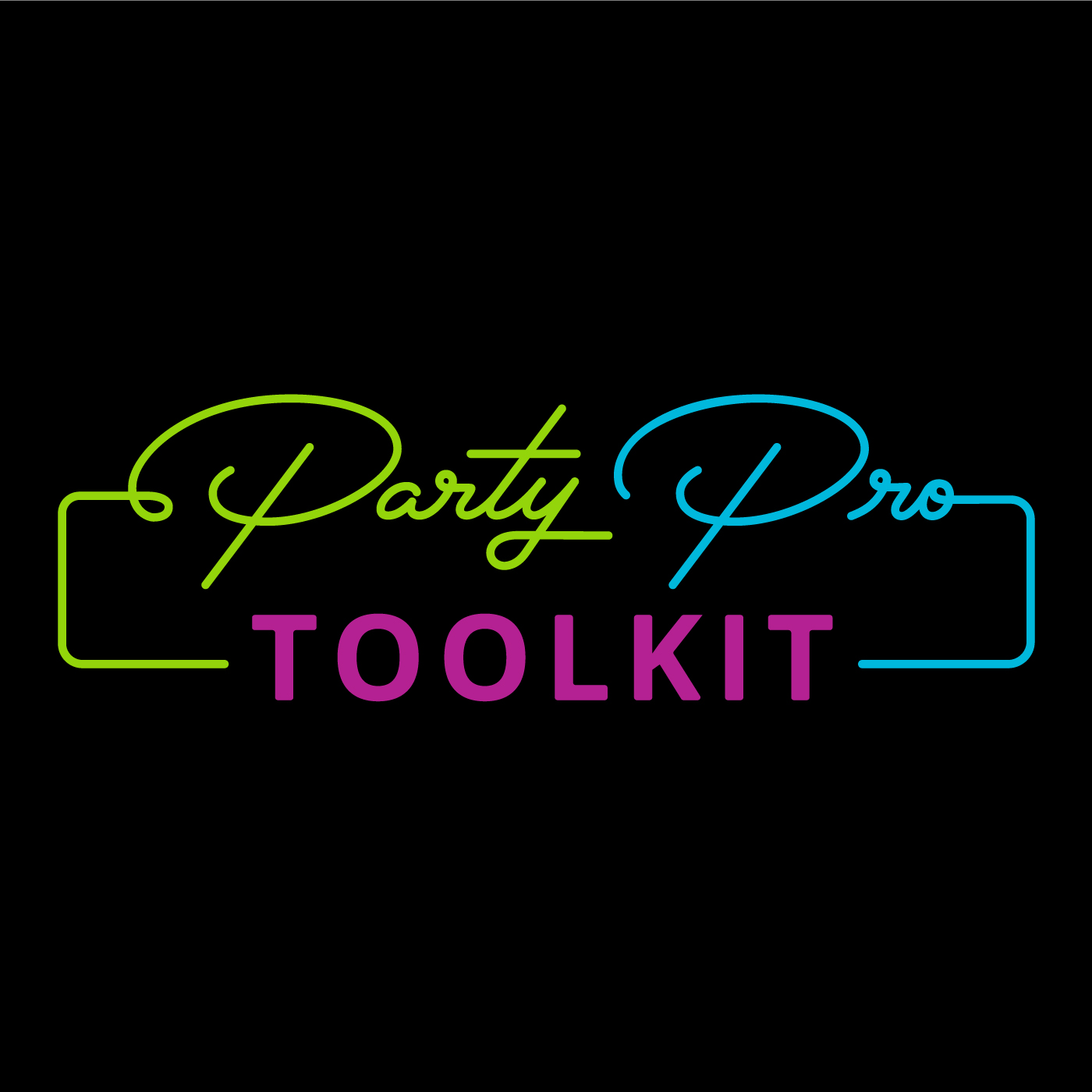Episodes
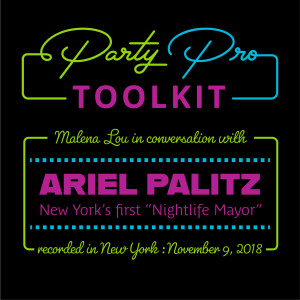
Monday Jan 11, 2021
Ariel Palitz, 'Nightlife Mayor' of New York - Nov. 9, 2018
Monday Jan 11, 2021
Monday Jan 11, 2021
Since the invention of electricity, we have had nightlife in our cities, offering a whole other experience from that of the daytime civic life. The nightlife is about socializing, experimenting, networking and expressing the aspects of ones self that we may not be able to expose at our day jobs. How interesting is the contrast between those two terms? Our Day Jobs compared with Night Life. It speaks to the duality of our lives and these two worlds that we live between.
Most city government officials operate on a 9-5, mon-friday schedule. This is their Day Job. Until recently, cities did not have official nightlife governance, an advocate or liaison between the many layers of the night-time ecosystem. There is a balance in this ecosystem, which has many stakeholders involved - the nightlife venues which generate the night-time economy, the residents of the neighborhood, law enforcement which responds to complaints or issues, the fire marshall who sets the standards for safety and the city government, which sets policy related to nightlife, often based on the complaints they would receive from the residents. Now, this is a tricky balance and every voice is important, which is where the role of the Nightlife Mayor comes in.
I had only recently learned about the implementation of Nightlife Mayors in major international cities, a movement which began with Mirik Milan, the first “Night Mayor” as he calls it, for Amsterdam in 2014. Since then, he has been able to work with the local government and the residents to find solutions or make adjustments to long-time nightlife issues, such as street noise. He supported the zoning of a 24-hour nightlife district in the city, which at first may seem counter-intuitive for solving the issue of street noise, however - this allowed the night time patrons to have a more natural flow throughout the evening, rather than ejecting all patrons from ever venue at exactly the same time.
SInce the appointment of Milan in Amsterdam, other cities have caught on, appointing their own representative of nightlife governance. Paris, London, Zurich and Washington DC are among over 30 cities that have introduced a form of nightlife governance, through an Office of Nightlife, Nightlife Advisory Boards, and/or a Nightlife Mayor. In the case of New York, Mayor de Blasio implemented all three. He appointed Ariel Palitz as the first Nightlife Mayor of New York, formally titled as the Senior Executive Director for the New York City Office of Nightlife at the Mayor’s Office of Media and Entertainment.
I was connected to Ariel through Olympia Kazi, member of the Nightlife Advisory Board and NYC Artist coalition, an advocacy group for artists which has organized mediation talks around the MARCH Raids and rallied behind the reversal of the Cabaret Law, both are hot button topics in the New York Nightlife scene.
I rode the elevator to the 27th floor of Manhattan City Hall on November 9, 2018, to meet with the first Nightlife Mayor of New York, Ariel Palitz. She filled me in on growing up in New York, her connection to the city, and her experience so far working in nightlife governance. She also shares with us some of the things she learned from running the Sutra Lounge, an inclusive, diverse and multi-faceted nightclub in Manhattan for ten years.
• • • •
The Party Pro Toolkit shares interviews with party professionals from Detroit, New York and Phoenix in 2018-2019. Learn more: partyprotoolkit.com
Produced as a graduate applied project by Malena Grosz, MFA, Arizona State University
Intro music: "Moonlight Bounce" by Daniel T (with permission for use)
Podcasts edited by Corbin Garcia
Special thanks to Herberger Institute for Design and the Arts at Arizona State University for grant-funded support of this project. Immense gratitude to my applied project committee for their guidance: Dr. Daniel Bernard Roumain, Dr. Rachel Bowditch, and Dr. Steven Tepper.
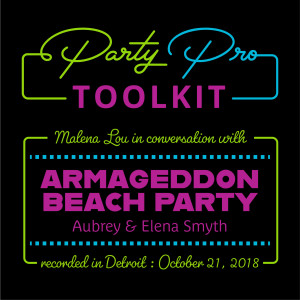
Monday Jan 11, 2021
Armageddon Beach Party Lounge, Detroit - Oct. 21, 2018
Monday Jan 11, 2021
Monday Jan 11, 2021
In a society that is obsessed with the end of the world, we are reminded that we are but passing tourists in this experience called life. When traveling as a tourist, one should make the most of their experience with the limited time they have. Armageddon Beach Party Lounge reminds us to embrace every moment, a name that represents the epic celebration at the end of the world. “If the world’s going to end, why not enjoy ourselves, and if it doesn’t, why not live life like it is?” co-creator Elena Smyth explains the concept behind their artistic brand while sitting next to her collaborative partner, Aubrey, in their newly opened brick and mortar store of the same name.
Nearly everything in Armageddon Beachparty Lounge is designed by the duo, each piece created as a full collaboration. The store includes a small stage for events, various collectible vintage items such as comic books, and a plethora of clothing and accessories printed with their painted designs. Their new store is meant to be a hub to connect the inner-city and subcultures of Detroit. All people and backgrounds, all forms of expression are welcome in this very personal and expressive multi-purpose art shop and venue.
Aubrey and Elena are living an arts-fueled love story that has been layered with synchronicities along the way. People refer to them as “one soul with two bodies.” This power-duo in Detroit has been together for ten years, creating collaboratively as self-employed artists for the last six. The most interesting proof of their cosmic connection came when they discovered matching birthmarks on their opposite hips, a symbol of their singular soul parting at birth.
These two self-made party professionals have built a micro-empire of artmaking and immersive event production that has progressed through their abilities to build community, brand their ideas and launch creative ventures with a marketing mindset. They were among the early members of the Recycle Here Recycling Center and contributed to the development of the adjacent Lincoln Street Art Park, formerly an abandoned lot near the train tracks where people would dump their trash. After converting the lot into a sculpture and mural garden, Aubrey and Elena co-produced festivals in the park with their friends at Botanical Fortress, focusing their efforts to curating immersive environments through large-scale installations. The events were free to attend and they built everything with materials from the recycling center. The festivals continued for four years until they became too large for the small park. This opportunity for free creative expression built the foundation for amazing things to come.
This interview took place on October 21, 2018 at Armageddon Beach Party Lounge. It was the morning after the final night of Theatre Bizarre, so we were all a wee bit tired, but I'm glad we were able to pull it together for this great conversation.
• • • •
The Party Pro Toolkit shares interviews with party professionals from Detroit, New York and Phoenix in 2018-2019. Learn more: partyprotoolkit.com
Produced as a graduate applied project by Malena Grosz, MFA, Arizona State University
Intro music: "Moonlight Bounce" by Daniel T (with permission for use)
Podcasts edited by Corbin Garcia
Special thanks to Herberger Institute for Design and the Arts at Arizona State University for grant-funded support of this project. Immense gratitude to my applied project committee for their guidance: Dr. Daniel Bernard Roumain, Dr. Rachel Bowditch, and Dr. Steven Tepper.
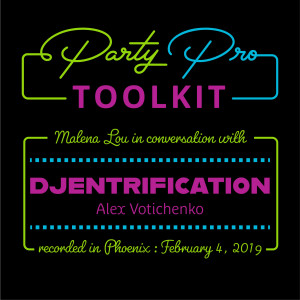
Monday Jan 11, 2021
Djentrification, Phoenix - Feb. 4, 2019
Monday Jan 11, 2021
Monday Jan 11, 2021
Alex Votichenko, also known as DJentrification, has become an icon of the Phoenix underground music scene over the last 20 years. This strictly vinyl DJ brings an eclectic sound to his sets, fusing together a diverse selection of world beats mixed with classic soul and modern electronic styles. When attending his shows, you are likely to hear music you’ve never heard before mixed into classics that you don’t hear enough.
As a native Phoenician, Alex was involved in the grafitti and underground dance scene in the early 90s. His passion for music started with creating mixed casette tapes until he was encouraged by some friends to start spinning on vinyl for their parties. Phoenix is a vast valley of connected communities that have gone through generations of shift. he’s seen his fair share of change and displacement in the Valley. Djentrification is his name, but it’s also his mission. He speaks out against gentrification and refuses to accept gigs from companies that contribute to it.
DJentrification is as authentic, grassroots and raw as they come. He’s not looking for promotion. He doesn’t want to make it big or prove himself to anyone. He’s also not afraid to use his microphone during a set to talk to the crowd, raise some funds for a friend in need, or call out that jerk in the front who needs to go drink some water. During his weekly 602sday residency at the Bikini Lounge in the historic Grand Avenue arts district, he has hosted water drives, sold burritos to raise money for a friend in need, and has utilized his status as a DJ to help others when he can. He also designs his own posters, which could justifiably create an epic retrospective exhibition on their own.
Alex invited me into his home on February 4, 2019 to discuss his experience growing up in Phoenix and his process of growth as a counter cultural vinyl DJ in this desert metropolis.
• • • •
The Party Pro Toolkit shares interviews with party professionals from Detroit, New York and Phoenix in 2018-2019. Learn more: partyprotoolkit.com
Produced as a graduate applied project by Malena Grosz, MFA, Arizona State University
Intro music: "Moonlight Bounce" by Daniel T (with permission for use)
Podcasts edited by Corbin Garcia
Special thanks to Herberger Institute for Design and the Arts at Arizona State University for grant-funded support of this project. Immense gratitude to my applied project committee for their guidance: Dr. Daniel Bernard Roumain, Dr. Rachel Bowditch, and Dr. Steven Tepper.
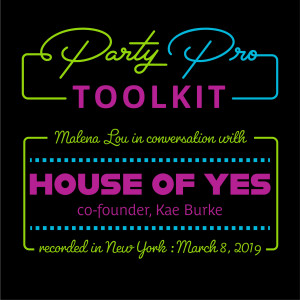
Monday Jan 11, 2021
House of YES, New York - March 8, 2019
Monday Jan 11, 2021
Monday Jan 11, 2021
The House of Yes in Bushwick, Brooklyn, has become recognized as one of the most iconic, immersive and inclusive nightclubs in New York. Their consent program alone has earned well-deserved reputation for its effectiveness. Almost every night of the week, you can find an eclectic mix of performances, queer culture, fantastic costumes and music from across the board. To me, the House of Yes is the first venue I’ve experienced that successfully captures the feeling and the ethos of Burning Man inside of a building.
The history of House of Yes is a story of perseverance, but also a successful example of an underground arts collective moving into the professional realm. The current venue is their third location, but the first of which that is a public, licensed and legal venue.
Anya Sapozhnikova and Kae Burke opened the first House of Yes in April of 2007 as a live-work and performance space. They hosted classes, performances and dance parties with a small group of resident artists. In less than one year, the venue burned to the ground from a kitchen fire. Within two months, they found a new location, twice the size. They had a community of supporters who assembled to help them fundraise and build out the new space. After five years of developing and recreating their multi-use venue space, they were forced to leave the venue due to an unreasonable rent increase. Once again, they had to start over.
This time, however, they decided to move out of the underground and bring in additional partners, Justin Ahiyon and ilan Telmont to help them create a licensed venue. More fundraising, more building, more community-collaboration led to the opening of the third and current House of Yes.
I met with Kae Burke at the Edition Hotel in Times Square, owned by former Studio 54 owner, Ian Schrager, and the home of their new dinner theatre performance called “The Devouring: A Marriage of Heaven and Hell,” hosted at the new Paradise Club four nights a week. Our interview took place on March 8, 2019, just before the first private dress rehearsals.
• • • •
The Party Pro Toolkit shares interviews with party professionals from Detroit, New York and Phoenix in 2018-2019. Learn more: partyprotoolkit.com
Produced as a graduate applied project by Malena Grosz, MFA, Arizona State University
Intro music: "Moonlight Bounce" by Daniel T (with permission for use)
Podcasts edited by Corbin Garcia
Special thanks to Herberger Institute for Design and the Arts at Arizona State University for grant-funded support of this project. Immense gratitude to my applied project committee for their guidance: Dr. Daniel Bernard Roumain, Dr. Rachel Bowditch, and Dr. Steven Tepper.
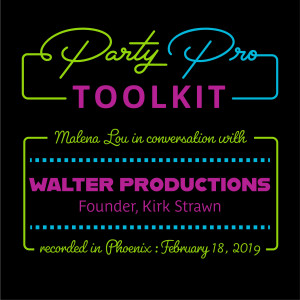
Monday Jan 11, 2021
Walter Productions, Phoenix - Feb. 18, 2019
Monday Jan 11, 2021
Monday Jan 11, 2021
If you’ve been to Burning Man, Electric Daisy Carnival, Bonnaroo or Life is Beautiful festival, you have likely heard of the infamous Kalliope soundstage and art car, part of the fleet of art cars created and toured by Walter Productions. Walter Productions is an incredible example of a Burning Man camp that has successfully transitioned beyond Black Rock City to extend their mission and impact to their home city of Phoenix, Arizona and beyond. In 2009, Camp Walter introduced their first creation, Walter, the world’s largest VW Bus, built at a 2:1 scale. Contrary to popular misconception, Walter is not named after a specific person – rather, his name comes from the fact that he was renovated from an old Walter Firetruck.
Since the birth of Walter in 2009, this community-led organization has expanded their fleet of art cars to include Big Red, the giant VW Beetle, Heathen the flame-throwing fire truck, Kalliope the muse and sound stage, the Peace Train, Pug Bug and Mona Lisa, which was based on Da Vinci’s drawings for a war machine, now brought to life as a symbol for facing our fears.
Along with the expansion of art cars, Walter extended their reach across America for several years by touring Kalliope and others to major festivals such as Bonnaroo and Electric Daisy Carnival. Now, they are taking root in their home community of Phoenix and extending into various projects such as The Where?House art gallery and venue, Walter Brewing Station, The Walter Gallery and Walter Dome, which hosts third Friday potlucks seasonally, and recently added a 501c3 project called The Walter Hive, which is a maker space that focuses on teaching skills to people from all walks of life, particularly at-risk youth and burn survivors.
It’s a lot to cover, but there is SO much good information in this conversation with Kirk Strawn, founder of the Walter Project and all of its affiliates. We talk about the process of building community, organizational structures, the importance of ethos for establishing a culture, finances, team dynamics and more. We’ll fill you in on the first ten years of Walter as we move into the second ten years of the 100 year plan for this community that is intended to build a legacy for years to come.
Toolkit Highlights:
- Learning through experience
- Bringing people together around a project (and beer)
- Work put into a project leads to a sense of ownership
- The transition from a Burning Man Camp into a local and national tour
- Preparing for the legacy of a project-based community
- Building partnerships and giving back to the greater community
- Formation of corporate and nonprofit entities for different projects
- The development of community guidelines
- The importance of inclusion and being nice
- Camp Walter’s mission on the playa and upcoming projects
- Moving from a volunteer-based project into a business
- The challenges of growth
- “It’s really all about people and teams”
- The time in between events
- The responsibility of the production team to the guests
- Looking forward to the next ten years for the Walter Project
• • • •
The Party Pro Toolkit shares interviews with party professionals from Detroit, New York and Phoenix in 2018-2019. Learn more: partyprotoolkit.com
Produced as a graduate applied project by Malena Grosz, MFA, Arizona State University
Intro music: "Moonlight Bounce" by Daniel T (with permission for use)
Podcasts edited by Corbin Garcia
Special thanks to Herberger Institute for Design and the Arts at Arizona State University for grant-funded support of this project. Immense gratitude to my applied project committee for their guidance: Dr. Daniel Bernard Roumain, Dr. Rachel Bowditch, and Dr. Steven Tepper.
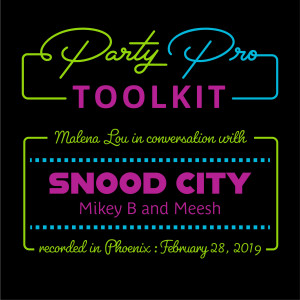
Monday Jan 11, 2021
Snood City, Phoenix - Feb. 28, 2019
Monday Jan 11, 2021
Monday Jan 11, 2021
Mikey B. (Michael Butzine) and Meesh (Michelle Meyer) have been developing as up and coming artists in the scene of Phoenix, Arizona. The creative couple has been hosting events, creating mixed-media art with Neon sculptures and most recently opened their own store and shop in the historic Grand Avenue arts district called Snood City Neon. They’ve found a niche working with local promoters, Relentless Beats to create art installations and environments for their large-scale EDM festivals hosted throughout the year. Over the years, I have had mixed feelings about commercialized, large-scale raves and electronic festivals. At the same time, it’s important to acknowledge that these events provide the first experience for many young people coming into the scene.
Mikey B and Meesh of Snood City in Phoenix share their personal stories about finding inspiration through art school and carrying what they learned into their professional endeavors. We met at their new store and shop at the historic Grand Avenue arts district on February 28, 2019 to discuss their journey and what they learned along the way.
• • • •
The Party Pro Toolkit shares interviews with party professionals from Detroit, New York and Phoenix in 2018-2019. Learn more: partyprotoolkit.com
Produced as a graduate applied project by Malena Grosz, MFA, Arizona State University
Intro music: “Moonlight Bounce” by Daniel T (with permission for use)
Podcasts edited by Corbin Garcia
Special thanks to Herberger Institute for Design and the Arts at Arizona State University for grant-funded support of this project. Immense gratitude to my applied project committee for their guidance: Dr. Daniel Bernard Roumain, Dr. Rachel Bowditch, and Dr. Steven Tepper
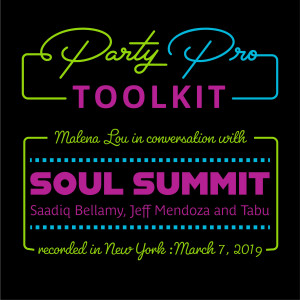
Monday Jan 11, 2021
Soul Summit, New York - Mar. 7, 2019
Monday Jan 11, 2021
Monday Jan 11, 2021
Soul Summit is a project that hits me right in the heart. It is an inspiring example of community-led party culture that brings together people from all walks of life to share in soulful music in a public space. This event began in 2000, at a time when Fort Greene in Brooklyn New York was evolving and changing. A historically black neighborhood saw the increase of gentrification and a mix of people moving into their neighborhood. Rather than resisting the change, Saadiq Bellamy, Jeff Mendoza and Tabu wanted to bring together the mixed community and unite people in the neighborhood through the simple concept of sharing music in the park.
When they were growing up, park culture was thriving. People would gather in the park every weekend to share music and socialize in the sun, getting people out of their houses and connecting with their neighbors. They felt that this communal ritual of their youth was lacking as they got older and they wanted to bring it back. People used to hear eclectic styles of music on the radio, but that eventually became homogenized as well, making the need to share more diverse music with the public even more essential.
Soul Summit is a free event that takes place several times every summer on Sunday afternoons in Fort Green Park. They receive the appropriate permits to host the event, but there are no barricades and no security, despite the fact that the event quickly grew into attracting 7 to 10,000 attendees. There is a strong culture of self-regulation and communal accountability among the participants that negates the need for such regulation.
Years back, three people called to complain about the noise during the event, raising some concern with the city office. Rather than back down, the Soul Summit organizers asked their community of attendees to call the city to voice their support of the event. Hundreds of phone calls poured in over the next week, shutting down the phone line because so many calls came in.
Free public events like this provide an important social good for communities - creating an inclusive social space for celebration, connection and expression. I would love to see this event inspire similar activations in other cities. Learn more about the development of this purposeful party in my interview on March 7, 2019 with Soul Summit founders Saadiq Bellamy, Jeff Mendoza and Tabu.
• • • •
The Party Pro Toolkit shares interviews with party professionals from Detroit, New York and Phoenix in 2018-2019. Learn more: partyprotoolkit.com
Produced as a graduate applied project by Malena Grosz, MFA, Arizona State University
Intro music: "Moonlight Bounce" by Daniel T (with permission for use)
Podcasts edited by Corbin Garcia
Special thanks to Herberger Institute for Design and the Arts at Arizona State University for grant-funded support of this project. Immense gratitude to my applied project committee for their guidance: Dr. Daniel Bernard Roumain, Dr. Rachel Bowditch, and Dr. Steven Tepper
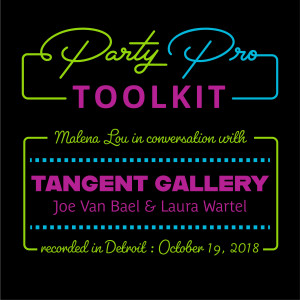
Monday Jan 11, 2021
Tangent Gallery, Detroit - Oct. 19, 2018
Monday Jan 11, 2021
Monday Jan 11, 2021
For me, Detroit has been layered with community connections that have led down one rabbit hole into another. I followed the momentum. People welcomed me in so easily, wanting me to learn about their city, inviting me into their community. After my first trip to Detroit, I already felt like I had found chosen family in the city. People I could count on, hang out with, stay with. There is beauty in the decay of Detroit. The people and the artists there are resilient. They operate with a high level of self-regulation and communal accountability, because, well, there was a time in Detroit when you couldn’t count on the police arriving, but you could count on your neighbor.
When it comes to community venues and a gathering place for artists, the Tangent Gallery is one of those special places in Detroit. It’s owned by Joe Van Bael, long-time resident and staple supporter of artists and crazy creative ideas. He started Tangent Gallery in 1999, around the same time as Theatre Bizarre.
My connection to Detroit started with Eric “Brick” Miller, the Burning Man Regional Contact for the area. He recommended I speak with Joe for this project, but was having trouble connecting with him. I bought a ticket for the Movement After Party at Tangent Gallery that night. I told Brick - Give me his name and a photo - I’ll find him. And I did.
Since that first night I stalked him and convinced him to be my friend, we’ve spent hours sitting on his rock outside of the Tangent, talking about the nightlife culture of Detroit and the many different events that artists have brought to his venue in the nearly 20 years since it has been in business.
Joe is one of the most genuine and down to earth people I’ve ever met. He introduced me to other people in the community and has hosted me on my two return trips to the city. When I open a nightlife venue, I want it to be based on the humble ethos that I have learned from Joe.
For this conversation we recorded at Tangent Gallery on October 19, 2018, we were joined by Laura Wartel, a young woman who has been booking shows at the Tangent for several years and contributes to the conversation as an artist and promoter. Laura is a natural entrepreneur. She shares with us some of the techniques she’s learned along the way for building a scene, producing events that push boundaries, and promotion techniques. Laura also runs a small business called Gallery Bypass, in which she invites artists to present their work at art parties without the red tape that can be found in most gallery applications.
• • • • •
The Party Pro Toolkit shares interviews with party professionals from Detroit, New York and Phoenix in 2018-2019. Learn more: partyprotoolkit.com
Produced as a graduate applied project by Malena Grosz, MFA, Arizona State University
Intro music: "Moonlight Bounce" by Daniel T (with permission for use)
Podcasts edited by Corbin Garcia
Special thanks to Herberger Institute for Design and the Arts at Arizona State University for grant-funded support of this project. Immense gratitude to my applied project committee for their guidance: Dr. Daniel Bernard Roumain, Dr. Rachel Bowditch, and Dr. Steven Tepper.
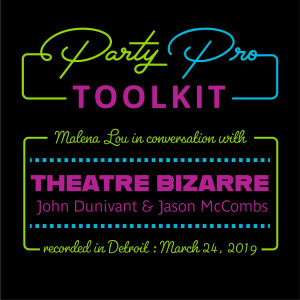
Monday Jan 11, 2021
Theatre Bizarre, Detroit - Mar. 24, 2019
Monday Jan 11, 2021
Monday Jan 11, 2021
Theatre Bizarre is one of the greatest parties in the world that you probably haven’t heard about. Why is that? Well, Detroit is pretty good about keeping secrets and the rest of the world is pretty good about ignoring Detroit. This series of interviews with party professionals from Detroit challenges those stereotypes to reveal the incredible creative projects that have been developing in this historic city.
Theatre Bizarre has grown into an elaborate, immersive, performative dark carnival themed party that spans 8 floors of the world’s largest Masonic Temple for two weekends leading up to Halloween. It is unlike anything else. In true Detroit style, the first ten years of Theatre Bizarre were developed under the radar and in a backyard, building year over year into a full scale hand-built theme park. It wasn’t until they brought the ferris wheel in for the ten-year anniversary that the fire marshall finally caught wind. When the event was shut down, they only had 18 hours to relocate. They found a new venue and their community came together, loading up pick up trucks to move the entire event and follow through for their ticket purchasers. After that fateful year, Theatre Bizarre had to go legal or give up. They decided to professionalize and party on. It wasn’t easy - shifting from complete creative freedom towards meeting the demands of the City, Permitting, Taxes, Insurance - But they did it, learning every step of the way.
In the 20 years since its inception, Theatre Bizarre has contributed to the professional development of thousands of performers, musicians, builders and makers in the Detroit area. People who started with Theatre Bizarre have made their learned practice a professional skill. Their fire safety technician has grown to become the lead fire technician for Burning Man and wrote the federal standard for fire performance safety. This event has been an important catalyst for creative professionals and saved the Masonic Temple from bankruptcy and deterioration.
This massive, immersive spectacle has done a lot for its community, but it also needs help. It’s not sustainable for Theatre Bizarre to continue in the Masonic Temple and they need to invest in their own space for the event and the community development to continue. Similar to how George R. R. Martin invested several million dollars to make Meow Wolf in Santa Fe a reality, Theatre Bizarre needs an angel investor to help this amazing project continue into its next phase. They need their own space that they can build out and use as a facility for the training and development of performers and artists. Learn more about the fascinating journey of Theatre Bizarre in this interview with founder, John Dunivant and his right hand man, Jason McCombs from March 24, 2019, the day before the Marche du Nain Rouge, another fantastic spectacle in Detroit you may not have heard about.
• • • •
The Party Pro Toolkit shares interviews with party professionals from Detroit, New York and Phoenix in 2018-2019. Learn more: partyprotoolkit.com
Produced as a graduate applied project by Malena Grosz, MFA, Arizona State University
Intro music: "Moonlight Bounce" by Daniel T (with permission for use)
Podcasts edited by Corbin Garcia
Special thanks to Herberger Institute for Design and the Arts at Arizona State University for grant-funded support of this project. Immense gratitude to my applied project committee for their guidance: Dr. Daniel Bernard Roumain, Dr. Rachel Bowditch, and Dr. Steven Tepper.

